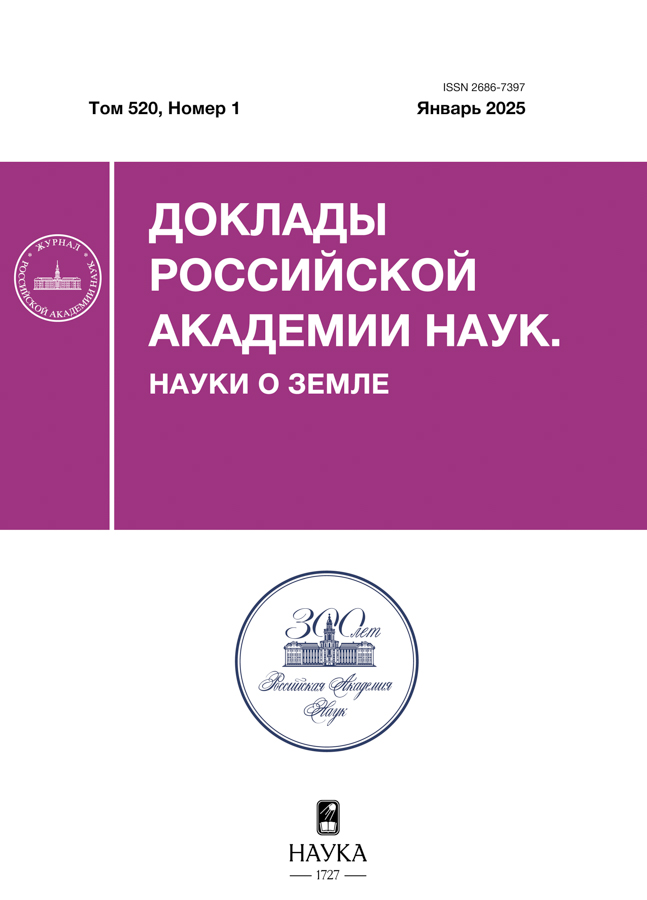Germanium-rich crusts of the sea of Japan
- 作者: Kolesnik O.N.1, Kolesnik A.N.1, S”edin V.T.1, Zarubina N.V.2, Karabtsov A.A.2
-
隶属关系:
- V.I. Il’ichev Pacific Oceanological Institute, Far Eastern Branch of the Russian Academy of Sciences
- FarEast Geological Institute, Far Eastern Branch of the Russian Academy of Sciences
- 期: 卷 520, 编号 1 (2025)
- 页面: 154-160
- 栏目: OCEANOLOGY
- ##submission.dateSubmitted##: 03.06.2025
- ##submission.datePublished##: 30.05.2025
- URL: https://edgccjournal.org/2686-7397/article/view/682417
- DOI: https://doi.org/10.31857/S2686739725010176
- EDN: https://elibrary.ru/GVLWPD
- ID: 682417
如何引用文章
详细
Ore crusts with a germanium content of up to 96 ppm were discovered in the Sea of Japan. This is tens of times higher than the clarke of the Earth’s crust. Germanium-rich crusts were dredged together with intermediate and felsic volcanic rocks. The crusts are composed predominantly of iron oxyhydroxides (goethite) and contain germanium in the dispersed state.
全文:
作者简介
O. Kolesnik
V.I. Il’ichev Pacific Oceanological Institute, Far Eastern Branch of the Russian Academy of Sciences
编辑信件的主要联系方式.
Email: kolesnik_o@poi.dvo.ru
俄罗斯联邦, Vladivostok
A. Kolesnik
V.I. Il’ichev Pacific Oceanological Institute, Far Eastern Branch of the Russian Academy of Sciences
Email: kolesnik_o@poi.dvo.ru
俄罗斯联邦, Vladivostok
V. S”edin
V.I. Il’ichev Pacific Oceanological Institute, Far Eastern Branch of the Russian Academy of Sciences
Email: kolesnik_o@poi.dvo.ru
俄罗斯联邦, Vladivostok
N. Zarubina
FarEast Geological Institute, Far Eastern Branch of the Russian Academy of Sciences
Email: kolesnik_o@poi.dvo.ru
俄罗斯联邦, Vladivostok
A. Karabtsov
FarEast Geological Institute, Far Eastern Branch of the Russian Academy of Sciences
Email: kolesnik_o@poi.dvo.ru
俄罗斯联邦, Vladivostok
参考
- Бортников Н. С., Волков А. В., Галямов А. Л., Викентьев И. В., Аристов В. В., Лаломов А. В., Мурашов К. Ю. Минеральные ресурсы высокотехнологичных металлов в России: состояние и перспективы развития // Геология рудных месторождений. 2016. Т. 58. № 2. С. 97–119.
- Иванов В. В., Кац А. Я., Костин Ю. П., Мейтов Е. С., Соловьев Е. Б. Промышленные типы природных концентраций германия. М.: Недра, 1984. 246 с.
- Frenzel M., Ketris M. P., Gutzmer J. On the geological availability of germanium // Mineralium Deposita. 2014. V. 49. P. 471–486.
- Волков И. И., Соколов B. C. Германий в железо-марганцевых конкрециях современных осадков // Литология и полезные ископаемые. 1970. № 6. C. 24–29.
- Волков И. И., Штеренберг Л. Е. Основные типы железомарганцевых руд в современных водоемах // Литология и полезные ископаемые. 1981. № 5. С. 4–26.
- Hein J. R., Mizell K., Koschinsky A., Conrad T. A. Deep ocean mineral deposits as a source of critical metals for high- and green-technology applications: Comparison with land-based resources // Ore Geology Reviews. 2013. V. 51. P. 1–14.
- Касимов Н. С., Власов Д. В. Кларки химических элементов как эталона сравнения в экогеохимии // Вестник Московского университета. Серия 5: География. 2015. № 2. С. 7–17.
- Прокофьев В. Ю., Наумов В. Б., Дорофеева В. А., Акинфиев Н. Н. Концентрация германия и галлия в природных расплавах и флюидах по данным изучения включений в минералах // Геохимия. 2021. Т. 66. № 3. С. 231–250.
- Mortlock R. A., Froelich P. N. Hydrothermal germanium over the southern East Pacific Rise // Science. New Series. 1986. V. 231. No. 4733. P. 43–45.
- Можеровский А. В., Грамм-Осипов Л. М., Волкова Т. И., Можеровская Л. В. Минералогические особенности железо-марганцевых образований Японского моря // Новые данные по геологии западной части Тихого океана. Владивосток: ДВНЦ АН СССР, 1989. C. 135–139.
- Колесник О. Н., Карабцов А. А., Съедин В. Т., Колесник А. Н. Первая находка гетитовых корок в Японском море // ДАН. Науки о Земле. 2022. Т. 505. № 2. С. 59–164.
- Колесник О. Н., Карабцов А. А., Съедин В. Т., Колесник А. Н., Терехов Е. П. Новый нетипичный случай железомарганцевой минерализации в Японском море // ДА Н. Науки о Земле. 2024. Т. 515. № 2. С. 245–251.
- Астахова Н. В. Гидротермальный рудогенез Японского моря // Геология и геофизика. 2021. Т. 62. № 9. С. 1191–1203.
- Берсенев И. И., Леликов Е. П., Безверхний В. Л., Ващенкова Н. Г., Съедин В. Т., Терехов Е. П., Цой И. Б. Геология дна Японского моря. Владивосток: ДВНЦ АН СССР, 1987. 140 с.
- Зарубина Н. В., Блохин М. Г., Михайлик П. Е., Сегренев А. С. Определение элементного состава стандартных образцов железомарганцевых образований методом масс-спектрометрии с индуктивно связанной плазмой // Стандартные образцы. 2014. № 3. С. 33–44.
- GeoReM: Database on geochemical, environmental and biological reference materials. http://georem.mpch-mainz.gwdg.de. Дата обращения: 10.07.2024.
- Дворкин В. И. Метрология и обеспечение качества химического анализа. М.: Техносфера, 2019. 317 с.
- Bau M., Schmidt K., Koschinsky A., Hein J., Kuhn T., Usui A. Discriminating between Different Genetic Types of Marine Ferro-manganese Crusts and Nodules Based on Rare Earth Elements and Yttrium // Chemical Geology. 2014. V. 381. P. 1–9.
- Vereshchagin O. S., Perova E. N., Brusnitsyn A. I., Ershova V. B., Khudoley A. K., Shilovskikh V. V., Molchanova E. V. Ferro-manganese nodules from the Kara Sea: Mineralogy, geochemistry and genesis // Ore Geology Reviews. 2019. V. 106. P. 192–204.
- Кобальтбогатые руды Мирового океана. СПб.: ВНИИОкеангеология, 2002. 167 с.
补充文件

注意
Presented by Academician of the RAS G.I. Dolgikh March 28, 2024












